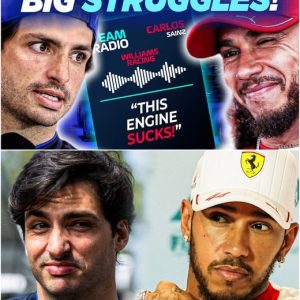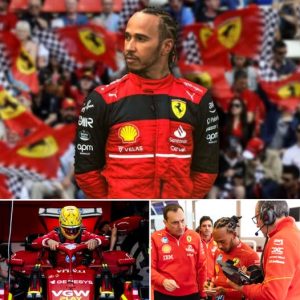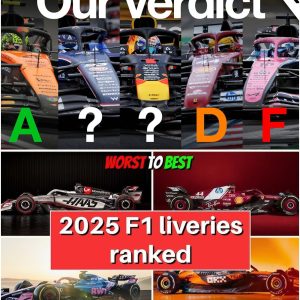Ferrari, the most historic and celebrated team in Formula 1, has always carried the weight of expectation on its shoulders. But in the 2025 season, something has felt off.
Ever since the infamous double disqualification (DSQ) at the Chinese Grand Prix, the team’s performance has been inconsistent, puzzling fans, experts, and analysts alike.
From technical woes to strategic uncertainty, Ferrari’s season has been marred by internal imbalance, risky gambles, and a car that no longer looks like a title contender.
Let’s dive into the facts and dissect what’s really going on with Ferrari in 2025.

The China Collapse: A Turning Point
The double DSQ in China was a significant blow to Ferrari’s momentum. Both Charles Leclerc and Lewis Hamilton were disqualified for excessive plank wear—an infringement that raised eyebrows and prompted serious questions. Since then, the performance trajectory has shifted, with Ferrari seemingly caught in a downward spiral.
The issue of plank wear may appear minor to the casual fan, but in F1, it’s a technical regulation that ensures teams don’t run their cars too low to gain aerodynamic performance. Exceeding the limit not only breaks the rules but suggests aggressive setups that sacrifice legality for speed. It was a red flag—literally and figuratively.
Hamilton vs. Leclerc: A Tale of Two Ferraris
Post-China, the performance contrast between Hamilton and Leclerc has only intensified. Leclerc managed pole and showed strong early pace at the Hungarian Grand Prix, but faded badly in the second half of the race due to a suspected chassis issue and a reported K1 engine fault. In contrast, Hamilton’s races have been plagued by brake and fuel management issues, often requiring extensive lifting and coasting—a method used to reduce fuel consumption and manage overheating components.
Herein lies the intriguing subplot: Ferrari seems to be running two very different race strategies on their drivers. Leclerc is possibly being allowed—or encouraged—to push the limits of legality and performance, running the car closer to the edge of what’s acceptable in terms of ride height and wear. Hamilton, conversely, appears to be taking the conservative approach: raising the ride height, avoiding aggressive floor setups, and managing critical systems throughout the race.
This has led to a unique dynamic: Leclerc risks disqualification but reaps short-term rewards (like pole positions), while Hamilton sacrifices peak performance for race-day security.
The Lifting and Coasting Dilemma
Lifting and coasting isn’t new in F1, but when it becomes a permanent fixture in a driver’s race, it signals deeper problems. In Hungary, Hamilton was repeatedly told to lift and coast—not just for tire management, but for brakes and fuel preservation. That’s not ideal in any situation, especially at a circuit like the Hungaroring, where overtaking is already challenging.
Compare that with Leclerc, whose lifting and coasting, when implemented, appears to be performance-focused: used to reduce plank wear and manage straight-line speed, thereby gaming the system just enough to stay within regulations. But that’s a razor-thin margin—one small miscalculation, and it’s another DSQ waiting to happen.
Upgrades or Downgrades? Ferrari’s Rear Suspension and Brake Package
Ferrari introduced a new rear suspension setup and upgraded braking systems this season, but results have been mixed. Notably, Leclerc received the new brake package in Canada, while Hamilton didn’t get it until Spa. The delay may have contributed to his rear-locking issues in sprint qualifying and track limit penalties later in the weekend.
The upgrades have not created parity between the cars. In fact, they’ve highlighted a broader question: Is Ferrari knowingly running two different configurations on its cars, and if so, why?
It could be due to driver preference. Leclerc has always had a reputation for pushing the limits, while Hamilton, now one of the most experienced drivers on the grid, often plays the long game. Or it could be a strategic experiment by the team—testing riskier setups on Leclerc’s side while keeping Hamilton’s car on a safer, more driven trajectory.
Regardless of the reason, the lack of harmony is hurting Ferrari in the Constructors’ Championship.
Strategic Gridlocks and DRS Trains
Hungary showcased one of Ferrari’s biggest weaknesses: track position. Poor qualifying for Hamilton resulted in him being stuck behind slower cars like Alonso, unable to make meaningful overtakes due to DRS trains and lack of straight-line speed. Even with a faster car, Hungary demands a significant delta to overtake, and Hamilton didn’t have the tools—or the track space—to execute.
Meanwhile, Leclerc’s race fell apart not from traffic but from mechanical issues and pit stop strategy, again reflecting Ferrari’s inability to deliver a complete weekend.
The Bigger Picture: Risk Management and Reliability
At its core, Ferrari’s issue in 2025 is one of inconsistent risk management. Leclerc’s approach may yield higher grid positions and occasional podiums, but it’s built on a precarious foundation. Hamilton’s method is methodical but hampered by technical limitations and outdated strategy.
Ferrari’s engineers must ask themselves: are we building a car that both drivers can trust? Or are we building a political minefield of preferential setups, uneven upgrades, and misaligned development goals?
There’s also the concern of reliability. Brake issues. Engine problems. Fuel management failures. All of these point to a deeper systemic problem—one that must be addressed before 2026 if Ferrari hopes to remain a serious contender.
Constructors’ Standings: A False Comfort?
Despite their issues, Ferrari currently sits second in the Constructors’ Championship. But that’s more a reflection of Red Bull’s inconsistency than Ferrari’s brilliance. With Max Verstappen carrying the load for Red Bull and his teammates struggling—Yuki Tsunoda, Liam Lawson, and rookie Kimi Antonelli all failing to perform at a high level—Ferrari’s position flatters to deceive.
It’s not sustainable. If Ferrari continues on its current path, it will be overtaken by McLaren or even Mercedes in the back half of the season. And with Aston Martin occasionally in the mix, the battle for second is wide open.
What Comes Next?
With the summer break arriving, Ferrari has a vital opportunity to recalibrate. They must:
Resolve their internal setup divergence
Establish parity in upgrade implementation
Address persistent brake and fuel system issues
Decide whether their strategy will be risk-heavy or risk-averse
In many ways, Ferrari’s 2025 season could be a turning point. With Hamilton nearing the twilight of his career and Leclerc still hungry for his first world title, the team must define its identity: are they a championship team or just another midfield powerhouse with legacy status?
Final Thoughts
Ferrari fans deserve better. Hamilton deserves better. Leclerc, despite his high-risk approach, deserves a car that doesn’t collapse halfway through a race. And most importantly, F1 deserves a competitive Ferrari team—not a fractured garage running conflicting strategies and hoping for the best.
So yes, let’s expose Ferrari—not to ridicule them, but to demand more from the sport’s most iconic name. The problems are real, the risks are visible, and the solutions are within reach. Whether Ferrari will act on them remains to be seen.
Until then, the prancing horse is limping—and time is running out to fix it.
Full Video:






